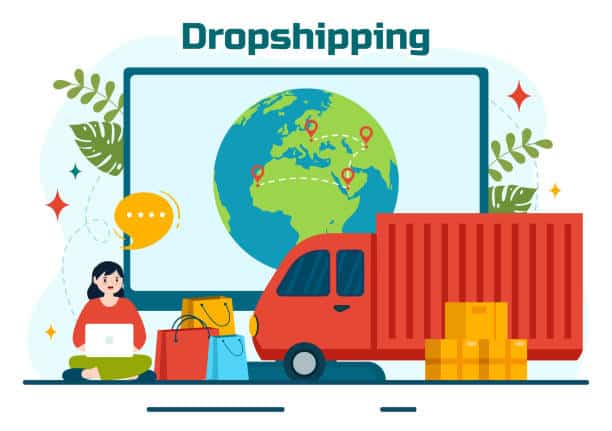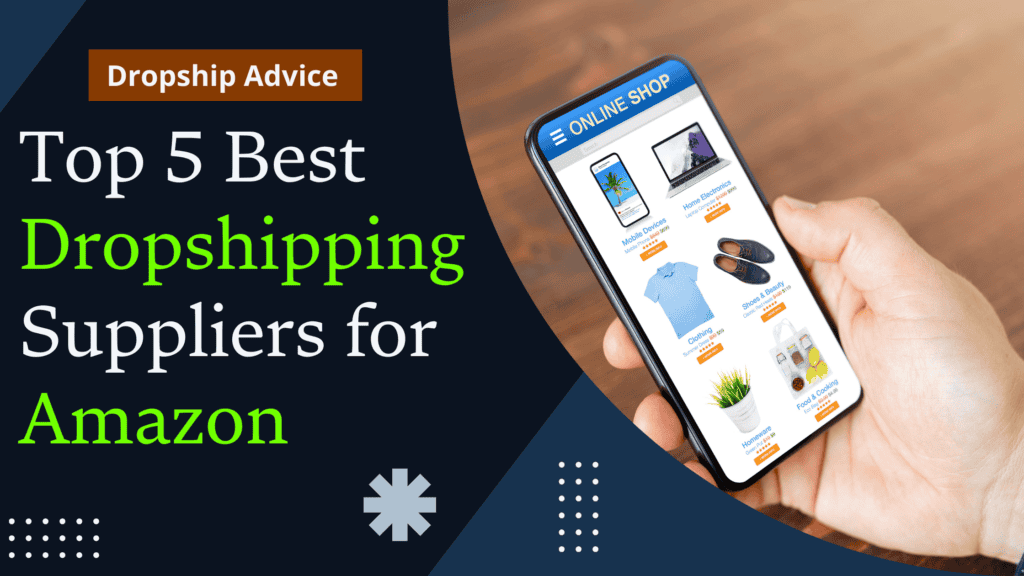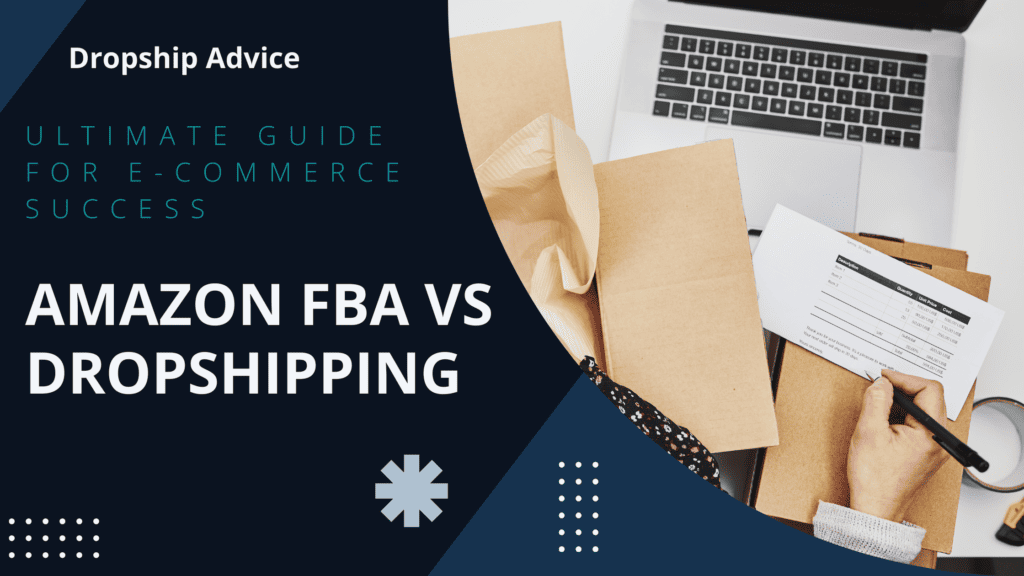The world of e-commerce has changed a lot. Dropshipping stays popular there. It’s big on platforms like Amazon. We are navigating through 2024. Picking the right dropshipping supplier is very important.
The right supplier can greatly impact your business. This is true if you use drop shipping for Amazon. It can affect your efficiency, customer satisfaction, and success.
This article is about dropshipping suppliers for Amazon. It covers the top five suppliers for Amazon in 2024. It gives insights into their offerings. It shows their reliability and what sets them apart in the market. Are you a seasoned seller or just starting? It will optimize your dropshipping business on Amazon.
What is Amazon dropshipping?
Amazon dropshipping is a retail method. An online seller lists products on Amazon. It do without holding any inventory.
Instead, when a customer buys a product, the seller purchases the item from a third-party supplier. The supplier then ships it to the customer.
This model allows sellers to offer a wide range of products. It can do this without the risks and costs of maintaining inventory.
Dropshipping on Amazon lets entrepreneurs focus on marketing and service and use Amazon’s vast reach and infrastructure to grow their businesses well.
Is Amazon dropshipping profitable?
Selling on Amazon can be profitable. But, its success depends on many factors. These include product choice, supplier reliability, pricing, and market demand.
Profit margins in dropshipping are lower than in traditional retail. This is because sellers often compete on price and need to cover costs. These costs include listing fees, shipping, and returns.

However, good market research and the right products can help. Social media, low prices, targeted ads, and strong customer service also matter. It let sellers achieve big sales volumes.
These makeup for the lower margins. Also, the low upfront investment and reduced risk are attractive. There is no risk of unsold inventory when dropshipping. It could be a lucrative business model for many entrepreneurs.
How do you dropship products on Amazon? Step-by-step Guide:
Dropshipping on Amazon can be profitable. However, careful planning, dropshipping services, and following Amazon’s policies are needed. Here’s a step-by-step guide on how to start dropshipping on Amazon
Step 1: Understand Amazon’s Dropshipping Policy
Before you start, learn Amazon’s dropshipping policy. Amazon allows dropshipping, but with limits:
- You must be the seller of record for the third-party sellers of your right products.
- It would help if you said you are the seller of product ideas. Do this on all packing slips, invoices, and other included product info.
- You must follow all other terms of your seller agreement. You must also follow applicable Amazon policies.
Step 2: Create an Amazon Seller Account
If you don’t already have an Amazon Seller account, you’ll need to create one:
- Go to Amazon Seller Central.
- Click on “Sign up” and choose the Individual plan or Professional plan. The Professional plan is best for those who plan to sell over 40 items per month.
Step 3: Find a Reliable Supplier
Finding a reliable supplier is crucial for a successful dropshipping business. You can find suppliers through:
- Wholesale directories: Websites like SaleHoo, Worldwide Brands, or Doba.
- Manufacturer websites: Contact manufacturers directly to inquire about the dropshipping business.
- AliExpress and Alibaba: These are popular platforms for finding multiple suppliers willing to drop ship.
Step 4: Research and Select Products
Select products that are in high demand and are in low competition. Tools like Jungle Scout or Helium 10 can help you analyze market trends. It can help you find profitable products in Amazon drop shipping.
Step 5: List Products on Amazon
-
Create a Product Listing:
- Log in to your Amazon Seller Central account.
- Go to “Inventory” and select “Add a Product.”
- If the product is on Amazon, search for it. Then, list it under the existing product page in the same category. If not, click on “Create a new product listing.”
-
Optimize Your Listing:
- Use high-quality images.
- Write a detailed product description.
- Use relevant keywords in your title and description.
- Set competitive low prices.

Step 6: Manage Orders and Customer Service
When a customer places an order:
- Order Fulfillment: Buy the product from your supplier. Then, please give them the customer’s shipping details. The package must have no branding or invoices from the supplier.
- Customer Service: Handle all customer inquiries, customer returns, and refunds promptly and professionally.
Step 7: Monitor Performance and Adjust Strategies
- Monitor Sales. Use Amazon’s Seller Central dashboard to track your sales and find trends.
- Adjust your pricing. Review it often and change it to stay competitive in dropshipping.
- Ask for reviews. It show that your products are good.
Step 8: Stay Compliant
Make sure you follow Amazon’s rules. This will keep them from suspending or ending your seller account. Regularly review Amazon’s dropshipping policy for any updates.
Additional Tips
- Automate Processes. Use tools and software to automate inventory management. It can also automate order processing, product listings, and price changes.
- Stay informed. Join Amazon seller forums and communities. It will keep you updated on best practices and industry trends.
- Grow Your Business. Once you have a successful dropshipping model, add more products and improve how you work.
Follow these steps. Keep a focus on customer satisfaction and compliance. Then, you can run a dropshipping business on Amazon.
Top 5 Dropshipping Suppliers for Amazon in 2024 :
AliExpress
Overview: A global marketplace offering a vast array of products at competitive prices.
The advantages are a wide product range. You can talk to suppliers directly. You can also link to popular e-commerce platforms.
Best For: Sellers looking for diverse product categories and competitive pricing.
SaleHoo
Overview: A wholesale directory and dropshipping platform featuring vetted suppliers.
It has advantages. It include access to over 8,000 trusted suppliers. It also have market research tools and great customer support.
Best For: Sellers who prioritize supplier reliability and detailed market insights.
Doba
Overview: An integrated dropshipping platform that connects sellers with suppliers.
Advantages: Easy product sourcing, automated order fulfillment, and inventory management tools.
Best For: Sellers seeking an all-in-one solution for managing their dropshipping business.
Wholesale2B
Overview: A platform providing access to millions of products from multiple suppliers.
Advantages: Comprehensive product catalogue, automated order processing, and seamless integration with Amazon.
It is best for sellers who want a wide selection of products. It has automation to streamline operations.
Spocket
Overview: A dropshipping marketplace focusing on high-quality products from US and EU suppliers.
It has faster shipping times. It has a curated product selection. It’s easy to integrate with Amazon and other e-commerce platforms.
It is best for sellers who target North American and European markets and need reliable shipping and premium products.
These suppliers offer many features and benefits and can optimize your dropshipping business on Amazon. It make sure you have access to quality products and fast fulfillment.
Is Dropshipping for Amazon legal?
Yes, Amazon dropshipping is legal. But, it must follow Amazon’s rules to comply. Amazon allows dropshipping as long as the seller is the seller of record for their products.

This means the seller must accept and process returns. It must also ensure the packaging, invoices, and other materials clearly identify them.
This must be recognized as the seller. Also, sellers must refrain from buying products from other online retailers. It can’t ship them to customers. By following these rules, sellers can run a dropshipping business on Amazon.
Amazon Dropshipping Policy:
Amazon’s dropshipping policy has specific guidelines. Sellers must follow them to comply with the platform’s rules.
Here are the key aspects of Amazon’s dropshipping policy:
Amazon seller must be responsible for
- It fulfill orders directly from the dropshippers to the customer.
- We are handling all customer service inquiries, including returns and refunds.
- It ensures customer satisfaction throughout the entire transaction by providing excellent customer service.
Packaging and Invoicing
- It must clearly identify themselves as the seller. It must do this on all packaging slips, invoices, and packaging.
- Don’t include any supplier’s info (if dropshipping). The customer might need to be informed of this. It might think the product came from the supplier rather than the seller.
Supplier Relationship
While Amazon allows dropshipping, sellers cannot:
- List products from another retailer on Amazon. Do this without first buying the product and then sending it to the customer.
- Use outside retailers or websites to fulfill orders. It do this by shipping from a supplier’s warehouse or using a supplier’s shipping account.

Compliance with Policies
Sellers must comply with all other Amazon policies, including
- Product listing policies (e.g., accurate product descriptions, images, and categorization).
- Performance metrics (e.g., order defect rate, cancellation rate).
- Selling policies (e.g., prohibited items, restricted products).
- Sellers are in charge of the quality of the products they list and sell on Amazon and must ensure that all products meet Amazon’s quality standards.
Prohibited Activities
Amazon prohibits certain activities related to dropshipping, such as:
- They are buying products from another online retailer. Then, having that retailer ship them directly to customers.
- We are listing products on Amazon store without having physical possession of the items.
Consequences of Non-Compliance
Non-compliance with Amazon’s dropshipping policy can result in:
- Suspension or termination of the seller’s account.
- Removal of product listings.
- Withholding of payments or funds in the seller’s account.
- Sellers must fully understand Amazon’s dropshipping policy and must follow it to avoid penalties. Doing so helps them maintain success on the platform.
- Sellers should review Amazon’s policies often and should look for updates or changes that may affect them.
Success Rate of Amazon Dropshipping
The success rate of Amazon dropshipping can vary widely. It depends on many factors. These include market conditions. It also include product selection, customer orders, and seller experience.
Finally, It include store and operational efficiency. Dropshipping on Amazon is hard. This is due to fierce competition. It is also due to strict seller metrics and Amazon’s focus on customer experience.
Success often depends on finding niche products. It have high demand but low competition. It also depends on managing inventory and orders well.

And on keeping competitive prices and margins. And on navigating Amazon’s complex seller policies and algorithms.
Some sellers do well. It achieve big profits. But, many others face hurdles. These include listing suspensions, high fees, and market changes.
Succeeding in Amazon dropshipping requires hard work. You need to do research and be adaptable. And you need a strategy to limit risks and use opportunities. This is key in the competitive e-commerce landscape.
Advantages of Amazon Dropshipping
Low Startup Costs
Benefit: You don’t need to invest in inventory upfront, significantly reducing initial expenses. This makes it accessible for entrepreneurs with limited capital.
You only buy products after getting customer orders. This avoids the risk of unsold stock.
Wide Product Range
Benefit: You can offer many products.
Easily expand your product catalogue. You can do this based on market trends and customer demand.
Scalability
Benefit: You can scale your business quickly without the constraints of physical inventory.
As sales grow, you can sell more products. This will let you expand your customer base. And you can do this without much extra cost.
Focus on Marketing and Customer Service
This benefits you. Suppliers handle logistics and inventory. So you can focus on marketing and improving service.
Better marketing and fast customer support can increase sales. It can also raise customer satisfaction.
Flexibility
Benefit: You can operate your business from anywhere with an internet connection.
For example, you can manage your dropshipping store while travelling. Or you can manage it from home.
Disadvantages of Amazon Dropshipping
Low-Profit Margins
The drawback is competition in dropshipping. It often leads to lower profits due to price cutting.
Example: You may need to sell a high volume of products to achieve substantial profits.
Limited Control Over Inventory and Shipping
The drawback is dependence on suppliers. It means you have less control over inventory and shipping.
Delays or errors from suppliers can upset customers. It can also lead to bad reviews.
Amazon’s Strict Policies
The drawback is that Amazon has strict rules on dropshipping. Follow them to avoid getting your account suspended.
You must ensure all orders are shipped in non-branded packaging. It would help if you also handled customer returns. It can be challenging.
High Competition
The ease of entry into dropshipping has a drawback. It leads to high competition, which makes it harder to stand out.
Example: Competing with numerous sellers offering similar products requires effective differentiation strategies.
Supplier Reliability
The drawback is that your business’s success depends heavily on your suppliers.
Inconsistent suppliers can lead to stock shortages. It also cause poor product quality and delayed shipments.
By weighing these pros and cons, you can understand the challenges. You can also see the opportunities for Amazon drop shipping. This will help you make informed choices and plan for a successful business.
Final thoughts on dropshipping on Amazon:
Dropshipping on Amazon can be a viable business model. But only for those who understand and navigate its complexities well.
However, it would help if you were realistic. You need to understand Amazon’s policies and how its marketplace works.
Success often needs careful product research. This is to find profitable niches. It also requires close attention to customer service and order fulfillment.
And a proactive strategy to manage inventory and pricing. The challenges include fierce competition, potential account suspensions, and high fees. It require resilience and adaptability.
In the end, dropshipping on Amazon can offer chances for growth and revenue. But, it needs a strategic and disciplined approach.
It would help if you had this to overcome obstacles. It will bring lasting profit in the tough e-commerce world.
FAQ’s on Dropshipping Suppliers
Is dropshipping allowed on Amazon?
Yes, dropshipping is allowed on Amazon. However, you must strictly follow Amazon’s dropshipping policy.
Sellers must ensure they are the sellers of record for their products. It must say they are the seller on all packing slips, invoices, and packaging.
It must also ensure their suppliers do not include any third-party information.
What are the main benefits and challenges of dropshipping on Amazon?
There are many benefits. You avoid large upfront costs because you don’t need to buy inventory in advance. You also get access to Amazon’s big customer base.
Plus, you can quickly scale by adding new products without needing more storage.
Challenges include reliance on suppliers for product quality and timely shipping. Also, lower profits are due to high competition and Amazon fees.
Plus, they need to comply with Amazon’s policies strictly. And the duty to handle returns and customer service.
How do I find reliable suppliers for dropshipping on Amazon?
Finding reliable suppliers is crucial. Look for suppliers with good reviews and ratings. You can find them on platforms like AliExpress, Shopify, and Oberlo. You can also find them at local wholesalers.
It helps you build relationships with suppliers. Test their reliability with small orders and should have low barriers and good product titles. Do this before scaling up.
It can help make sure they meet your standards for quality and fulfillment.
What happens if my supplier runs out of stock?
If your supplier runs out of stock, you must quickly update your Amazon store listings. This is to show the out-of-stock status. It keeps you from selling items you cannot fulfill.
Keep in regular touch with your suppliers. Use it to watch inventory levels. Also, have backup suppliers. It can help reduce this risk.
Conclusion of Dropshipping Suppliers for Amazon:
Dropshipping on Amazon is an easy way to start an e-commerce business. It has low upfront costs. It’s great for entrepreneurs.
It lets sellers use Amazon’s big customer base and infrastructure and can avoid the complexities of managing inventory.
But, it requires diligent research. It also needs reliable suppliers. You must also follow Amazon’s policies. This is to keep quality and customer satisfaction.
Competition can be fierce. Profits may be thin. But with careful planning and execution. Dropshipping on Amazon can be a viable and profitable venture.
Adaptability and continuous learning are key to thriving in this dynamic marketplace.



